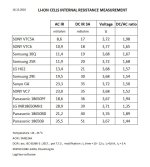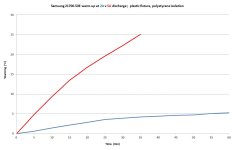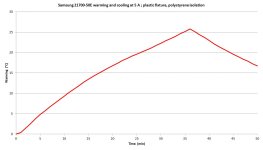SamRich said:
Jonathan1981 said:
Mj31's are 3.5ah, LG M50's are 5ah with just the slightest increase in cell size.... so M50's win hands down except for price...
am I missing something?
I don't have the numbers here for the m50s but when I calculated how many cells I could fit in the same volume, I got pretty much the same Ah in mJ1 as m50s. Your box might take better advantage of the 21700 form factor but the increase in size isn't as "slight" as you think.
Volume of 18650 = 16532mm^3 -> 0.212 mAh/mm^3 for 3500mAh
Volume of 21700 = 24233mm^3 -> 0.206 mAh/mm^3 for 5000mAh
So Mj1 is actually slightly higher energy per volume + 18650 will also have a higher packing fraction (less air between cells).
21700 are cheaper to produce than 18650 (per mAh) and cheaper top assemble in batteries (fewer cells per Ah). So that's likely why we are seeing push towards largers cells.
But for DIYer 18650s MJ1 are better options at current cost.
Sam, you don't need to go as far a pack size, just do a simple ratio comparing dims vs. capacity.
71/65= ~1.09
700/650 = ~ 1.09 so let's just say .09% larger...
capacity figures: 5/3.5 = ~ .43 % more capacity. .43-.09 = .034... so if my math and logic are correct, per unit size, the 21700 is 34% more energy dense... or in other words, if you had an 18650 (Mj1 etc.) and a 21700 of equal size, the 21700 would be 34% more capacity... so it wins.
This is obviously a rough estimate and is probably less in real life..... oh wait. Here you go.
"According to Tesla, Power density of 21700 goes up to 300 Wh/kg, which is about 20% more than current 8650 batteries that rates at 250Wh/kg."
But I don't think this negates 18650's, they'll be around for a long time still, especially as 21700's become the norm, 18650's are going to get really cheap making them a nice balance of kwh/ah/cost....
I'm going to design a pack for both cells...
Anyone know of a good place to get cell holders CNC machined out of sheets of ABS or acrylic???
cheers




